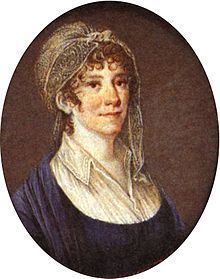Name Therese Huber Role Author | Parents Christian Gottlob Heyne | |
 | ||
Children Victor Aime Huber, Luise Huber Books Discipline: a novel, Sophie, Ellen Percy | ||
Therese Huber (7 May 1764 – 15 June 1829) was a German author. She was one of the so-called Universitätsmamsellen, a group of five academically active women during the 18th-and 19th century, daughters of academics on Göttingen University, alongside Meta Forkel-Liebeskind, Caroline Schelling, Philippine Engelhard, and Dorothea Schlözer.
Contents
Life
Therese Huber was born Marie Therese Heyne in Göttingen as daughter of the influential classical philologist Christian Gottlob Heyne. She married traveller and ethnologist Georg Forster in 1785. They lived in Wilno 1785–1787 and in Göttingen and Mainz 1788–1792 and had three children, but an unhappy marriage. After Forster had left Mainz for Paris as representative of the Mainz Republic, she and her lover Ludwig Ferdinand Huber, who had been living with the Forsters in Mainz, moved to Neuchâtel, living under difficult conditions there. She and Forster met for the last time in 1793, when he agreed to a divorce. However, Forster died soon after, and she married her lover. After his 1804 death, she moved in with her daughter in Ulm. Huber died in 1829 in Augsburg. The most notable of her ten children, six of which survived, was social reformer Victor Aimé Huber.
Works
Huber's main work consists of novels, novellas, and travel reports, at first published under her husband Ludwig's name. However, she was also working as editor of the Morgenblatt für gebildete Stände (Morning paper for the educated classes), as translator, and as essayist. Furthermore, she wrote over 4500 letters to many important contemporaries, about a wide range of topics. Later in her life, Huber edited the works and letters of both of her husbands. Her novel, Abentheuer auf einer Reise nach Neu-Holland [Adventures on a Voyage to New Holland] was serialized in the 1793-1794 issues of the German women’s magazine, Flora: part of the tale was set in Norfolk Island, which thus made its first appearance in a work of fiction. Georg Forster had been one of the party of the first Europeans to ever to set foot on Norfolk Island when it was discovered in October 1774 during Cook’s second voyage, and Therese had drawn on his description of it in his Reise um die Welt.
Publications
(in German) Therese Huber's published works as cited by An Encyclopedia of Continental Women Writers.
Other Publications
